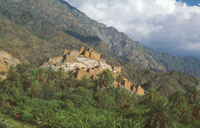
A determined Saudi Arabia has put out all stops to take advantage of the country’s abundance of cultural heritage to attract discerning visitors who want to experience the cradle of Islam.
Covering an area one-fourth of the US, the Kingdom has a diverse topography. There’s plenty of desert, including the vast Empty Quarter in the south, but there are also mountains, valleys and Red sea beaches with turquoise water known for some of the world’s finest diving
The Kingdom is also rich in archeological sites, including the spectacular tombs and dwellings carved into sandstone 2,000 years ago by the Nabateans, the lost civilization that created Petra in neighbouring Jordan.
The country is huge and newly developed, yet many places are hard to reach and lack basic tourist facilities. The Nabatean ruins at Madinat Salai, for example, are a four-hour drive from Madinah, the nearest city with an airport.
However, the importance of tourism led to the establishment of the Supreme Commission for Tourism (SCT) by a royal decree on April 16, 2000. The SCT is the first fully-independent body to handle and develop all aspects of national tourism in Saudi Arabia, according to Prince Sultan Bin Salman who heads the SCT.
The strategic plan has included the SCT initiatives to implement the tourism human resources development through launching the National Project for Tourism Human Resources Development (NPTHRD). The NPTHRD provides requirements for operations, education and training in accordance with the latest international occupational standards.
The SCT was created as part of effort to diversify Saudi Arabia’s economy, which is almost totally dependent on oil. Much of the country’s wealth is invested abroad, including an estimated $700 billion in the US. Saudi Arabia’s ongoing development in the private sector, especially the booming real estate, is indicative of the funds being repatriated by investors since 9/11. So there has been a rapid development of the tourist infrastructure like hotels, apartments, recreation centres and beach resorts around Jeddah and also in the Eastern Province on the Gulf coast and the capital city Riyadh.
The all-round effort to promote domestic tourism is yet to yield fruit. Despite the impact of 9/11, vacationers head for the US and Europe during the three-month summer holiday for schools, taking with them more than $15 billion to spend.
In the last three years, in particular, tourists from within the Kingdom have been spending their summer vacation in different parts of the country. According to a study, about 50 per cent of the vacationers who used to travel overseas or other nearby Gulf and Arab countries now remain within the Kingdom, visiting its various cities and attractions.
Yet, Prince Sultan is confident and optimistic that tourism could be developed further to attract domestic tourist and thus could create more than 1.7 million jobs in the next 20 years. Many of the jobs could go to Saudis whose unemployment rate is estimated to exceed 30 per cent.
Every year, Saudi Arabia draws more than 4 million Muslims from the world over who come to perform Hajj, the annual pilgrimage, and year-round Umrah (small pilgrimage).and also visit Madinah to pray at the Prophet’s Mosque.
Additionally, some one million residents of the Kingdom also perform Hajj. Aside from these there is regular inflow of visitors for business and tourism, although they total around 6,000 a year. Most of the non-Muslim tourists come in tour groups organised by Saudi Arabian Airlines, the national carrier.
“It’s imperative to keep a close eye on those who enter the Kingdom, especially after the 9/11 attack on the US,” said Prince Sultan. After all, America today is not the same as it was before 9/11 and it is taking extra care and precaution to see that its security is perfectly guarded.
Despite the obstacles, Prince Sultan thinks Americans and other non-Muslims can have a fine time in Saudi Arabia as long as they accept that they’re in a radically different culture. “We’ve focused on value tourism, reasonable prices, good facilities, and first-class treatment from the minute they get here until they leave,” he said. “The challenge is also to make tourism fun and not a serious affair.”
Saudi Arabia’s attractions are many and varied. Dating back more than a million years, many places in the Kingdom are ancient and historical and feature landscapes with spectacular and fascinating views. Sports fans can enjoy themselves swimming, diving, parachuting and even bungee jumping. Modern shopping malls and traditional old markets are part of the Kingdom’s heritage and history.
The Kingdom is also dotted with parks and amusement centres. These are some of the things that impress and attract domestic tourists. In Jeddah alone, thousands of visitors from other parts of the Kingdom can be seen every summer to enjoy its beaches and recreation centres. Hotels and apartments are heavily booked and occupied during the summer months with the rates of apartments and chalets touching astronomical figures. They go up to and beyond SR300 per night per family.
It is against this background that Prince Sultan is working on a project that will increase the annual number of visitors from 20.8 million to 44 million over the next 20 years. The current tourism industry is worth $10 billion annually and is estimated to more than double in 20 years.
The plans include building an extra 50,000 hotel rooms over 10 years to add to the nearly 1,00,000 that already exist. The industry will also need 74,000 more apartments over the next decade.
Some 38 tourism development areas and 175 designated tourist sites have been identified in the Kingdom, which mainly targets local Saudi tourists, Hajj and Umrah pilgrims, GCC and Arab nationals, and foreign tourists. Fifty tourism development authorities will be developed within 20 years, with the government playing the role of regulator and facilitator rather than an investor and owner.
The Kingdom’s Council for Public Investment is working with the Supreme Commission for Tourism to generate funds for investment in tourism.
